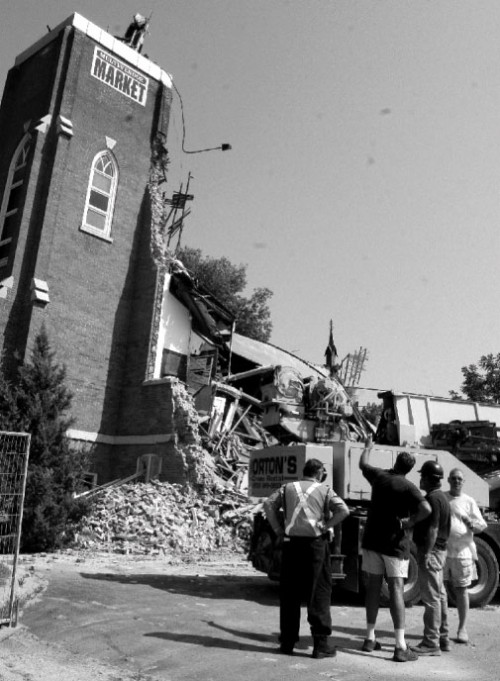County News
Whose call is it?


The spectre of the brick church looms over every built heritage decision since it was destroyed in 2010.
Advisory Committee says council must consult with it before making a decision to delist a home from the Heritage Property Register
Three years after a rogue contractor smashed in the side of a 130-year-old church on Main Street in Picton, County council and its heritage advisory committee are at odds over how to protect and preserve historic properties in the hands of private owners. Who makes the call?
On one side are Prince Edward Heritage Advisory Committee (PEHAC) members who are urging council to be more assertive in protecting historic and significant architecture in its Heritage Properties Register. On the other are a majority of councillors increasingly uneasy about telling private owners what they can and cannot do with their property.
The latest clash occurred with council’s recent decision to permit the 87-year-old owner of an Athol home to have her home taken off the County heritage register. She was trying to sell her home at 891 County Road 11, but prospective buyers had been scared off by the listing and the potential for historic designation.
The delisting of her home happened over the objections of PEHAC members who pointed out the only effect of the listing was that it would delay by just 60 days the issuance of a demolition permit in the event the owner sought to tear it down. In this way the register would give the municipality and the community time to consider alternatives to the loss of a significant heritage and cultural asset.
In this instance, Council sided with the homeowner over its own advisory committee. This decision has PEHAC members questioning their role and purpose in the municipality’s decision making. Specifically they want council to square its role with the role prescribed by the Ontario Heritage Act.
“Can council override the Ontario Heritage Act?” asked Janice Gibbons, PEHAC chair. “It was pointed out that the Ontario Heritage Act Section 27 requires that in delisting requests that council consult with its heritage advisory committee before delisting.”
Gibbins asked the committee of council to defer delisting the Young-Woodward property until it could determine the validity of the delisting process.
Complicating the issue is that when council expanded its Heritage Register after the brick church fiasco, it failed to notify many homeowners their property was now on the list and protected from demolition for 60 days. Many property owners only learned their home was on the Register after updates to the list was published by the Times. In response to the pushback council agreed it would delist any home simply by written request of the homeowner.
Gibbins argues it is isn’t, nor should it be, that easy. She says the OHA compels the council to act upon its advice—that only PEHAC has the authority to remove homes from the register. At the very least she wants council members to understand the Ontario Heritage Act better so as to “avoid another brick church calamity”.
Gibbins went on to observe that a great deal of energy and resources had been expended by PEHAC in working to preserve and evaluate the property. She said that effort was wasted if council ignored its advice.
“The OHA is our bible,” said Gibbins. “The County should get a legal opinion to clarify this.”
Athol councillor Jamie Forrester pondered a basic question.
“Who is responsible for heritage?” asked Forrester. “Do we not have a responsibility to make sure somebody is protecting our heritage?
The County’s manager, Merlin Dewing, explained that council was obligated to consult with its Heritage Advisory Committee on heritage matters but wasn’t compelled to take its advice.
Councillor Alec Lunn read the Act differently.
“Council shall consult,” read Lunn. “That means we don’t have a choice.
“All we are asking is for some time to think about what might be lost. It’s a real shame.”
Others argued, however, that the Ontario Heritage Act, sought to impose restrictions that carried with them financial implications for both the property owner and the municipality—without any financial remedy.
“If the province believes the property is crucial, then they should buy it,” said Terry Shortt, a Sophiasburgh councillor. “Somebody has to take financial responsibility for these decisions—not just the property owner.”
Lunn insisted the burden upon owners of heritage properties was minor.
“This just buys us time,” said Lunn. “So many people said after the church was destroyed, ‘If I’d only known.’”
He added that misconceptions abound among property owners—among them that PEHAC designates properties of significant cultural or heritage value— and also an array of constraints upon an owner of such a property greater than simply a listing on the Heritage Property Register.
“PEHAC doesn’t designate properties, council does that,” said Lunn. “Council can designate a property without the homeowner’s permission according to the OHA. But this council would never do that. This has led to a lot of hysteria.”
Shortt countered by pointing out that such restrictions— even minor—are perceived as reducing the salability of the home.
“It’s my house, I paid for it,” said Shortt. “These restrictions send buyers away. If the province says this is important, they should give us the resources to do it. We have an 87-year-old woman whose family has owned the home since 1912. Now we are going to to make it harder for her to sell her home?”
Lunn tried to steer his colleagues toward postponing a decision until it could gather more advice as to who makes the delisting call—but the majority of council felt they already knew the answer. It agreed to uphold the current process by which owners of property on the County’s Heritage Register may have it removed simply by requesting so in writing.

Comments (0)